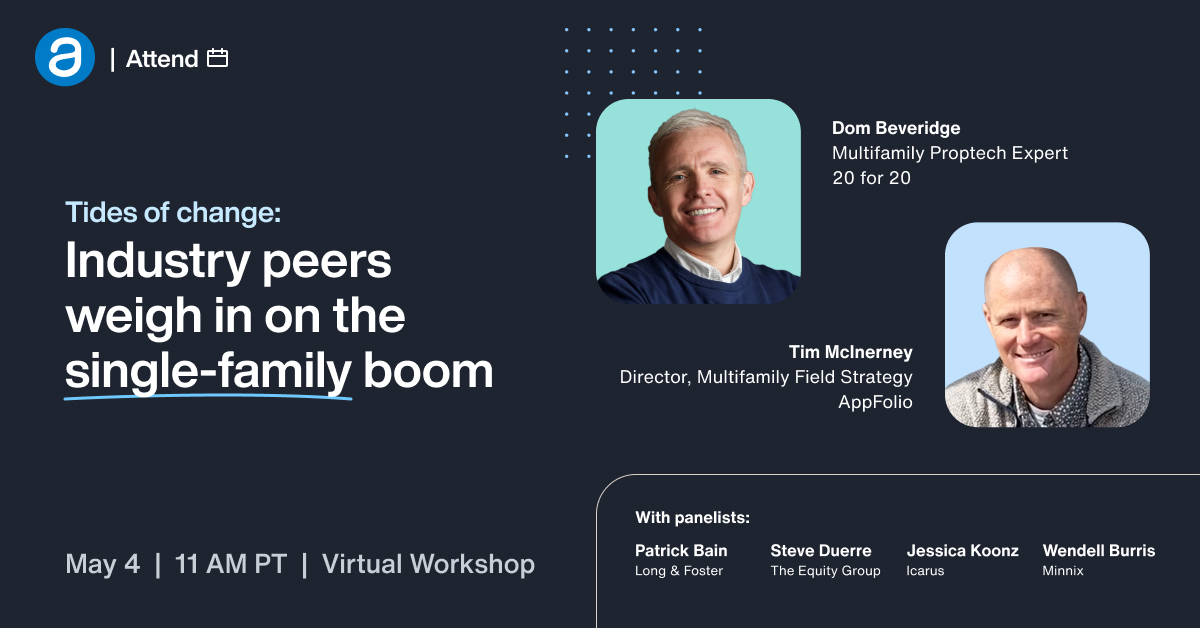
A week ago, I was taking part in a panel at AIM 2022. The panel compared two pieces of research (the NMHC/Grace Hill Renter Preferences Study and 20 for 20) to highlight the differences between the viewpoints and priorities of operators and their residents.
The session covered property tours extensively, as we considered the work that operators are currently doing to automate and – where possible – centralize core processes. It made me think about some work that I’ve been doing recently in the single-family rental (SFR) space and some things that multifamily operators can learn from their more geographically-dispersed brethren.
Why pay attention to Single Family Rentals?
It’s a good question. A few years ago, when I was researching the first-ever 20 for 20 report, there was a surprising level of push-back against allowing prospects to self-show in multifamily communities. By that time, SFR operators had already achieved impressive success with self-guided tours, so why wasn’t multifamily following suit?
Of course, there are different business drivers at play: self-show is a necessity in SFR because the properties are usually too dispersed for a multifamily-style leasing model. SFR operators do not have to account for common areas, neighbors within the same building, and the various challenges associated with apartment buildings. But the lockdown phase of the pandemic normalized self-show in multifamily, and the industry has largely started to follow SFR’s lead.
That’s one good reason for considering paying more attention to SFR experiences and operating models. Another is that an increasing number of multifamily operators are diversifying into the SFR space. According to this year’s 20 for 20 survey, 20% of the (multifamily) respondents were at some stage of moving into SFR operations.
It’s a good question. A few years ago, when I was researching the first-ever 20 for 20 report, there was a surprising level of push-back against allowing prospects to self-show in multifamily communities. By that time, SFR operators had already achieved impressive success with self-guided tours, so why wasn’t multifamily following suit?
Of course, there are different business drivers at play: self-show is a necessity in SFR because the properties are usually too dispersed for a multifamily-style leasing model. SFR operators do not have to account for common areas, neighbors within the same building, and the various challenges associated with apartment buildings. But the lockdown phase of the pandemic normalized self-show in multifamily, and the industry has largely started to follow SFR’s lead.
That’s one good reason for considering paying more attention to SFR experiences and operating models. Another is that an increasing number of multifamily operators are diversifying into the SFR space. According to this year’s 20 for 20 survey, 20% of the (multifamily) respondents were at some stage of moving into SFR operations.
Are multifamily and SFR converging?
The trends pushing investors to get into the SFR business are compelling. Young renters considering moving to their first single-family home are increasingly priced out of buying one. At the same time, attitudes to home-ownership among renters seem to be changing. For many, renting a house where services like internet and landscape maintenance are part of the package is more appealing than buying a house and being responsible for maintenance.
The rise of work-from-home has also made SFR more attractive as renters move further from the office in search of more space. But the bias amongst multifamily operators and investors seems to be towards a specific kind of SFR: “Build For Rent” (BFR). In this model, a developer creates neighborhoods of houses and runs them similarly to multifamily communities.
BTR (referred to by some as “horizontal multifamily!”) is a natural extension of the multifamily model. While BTR is a natural point of convergence between the asset classes, it does not offer the same range of learnings for the multifamily industry (like the self-show example above).
In the more traditional, opportunistic SFR model, also known as the “scatter-buy” model, operators accumulate portfolios of assets that are separated by distance. Operators in this space have had to figure out solutions to new problems of distance and scale, rather than designing neighborhoods to which they can apply a multifamily operating model. I think they have much to teach the multifamily industry.
About those learnings…
This week, I am excited to participate in another industry panel. This time I will be discussing the SFR model with four successful SFR operators. The session will focus on how each company approaches operations, from finding assets and investors, developing their portfolios, and—of course—how their operating models work.

Through researching the panel, it has become clear to me just how different SFR portfolios can be. Some operators aggregate “accidental landlords,” e.g., those renting out their homes rather than selling them when they move house. Others grow by working with landlords to help them grow their own SFR portfolios. There is the risk of administrative overload with many small landlords, especially with functions like maintenance. We will explore on the panel some of the innovations that operators have implemented to manage the workload.
To operate SFRs, companies must do the same things that multifamily operators do; they just have to set them up differently. Two of the four panelists have mixed multifamily and SFR portfolios, and we will discuss how their operating models “stretch” to handle both asset classes at once.
There is still time to register for the session, which takes place on Wednesday, May 4th, at 11am PT. You can expect an insightful discussion that covers operational innovation, an assessment of the current SFR opportunity and the ways different types of companies are exploiting it. The conversation will be rich in learnings whether you’re a multifamily operator that is curious about the asset class or just keen to learn from others’ operational experiences.
Please join and be part of the conversation!
Photo by David McBee


